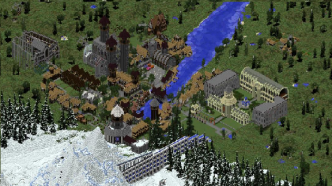The PCB wiki has now been archived and is read-only. |
Asteria
Asteria, founded in February of 2018, is a small merchant republic due directly south of the spawn, its nearest cities being Kanata and Sujin. Created by JHD1124, its rapid expansion over its short existence is due in part to its random, simple build style. It's two main cities, Asteria City and Rutherford, are both an anachronistic medieval/fantasy style which bridges Tudor, Gothic, and Edwardian architecture styles. Asteria is more dedicated to a stricter palette, using mostly stone brick, spruce logs, and white wool to make up a majority of its buildings.
Towns in Asteria
Asteria is currently composed of two towns, Rutherford and Asteria City. Both are situated on the Quotidienne River. Each serves unique socio-economic and industrial purposes.
- Asteria City:
- The current capital of the merchant republic, Asteria City (usually referred to as Asteria, interchanged with the republic) is a developing port city with a focus on the economy, trading, and merchant activities. The First Bank of Asteria, the building in which players spawn, sits as a prominent reminder of the economic power of the city. A number of buildings in Asteria City reflect this nature including:
- Merchant Guild
- Market Square
- Large Warehouse
- Smaller port warehouses
- A number of local trade businesses including a florist, a jeweler, a baker, etc.
- Asteria is also home to an expanding upper-class residential neighborhood, named Grand Althea. Nestled in between the First Bank of Asteria and Fort St. Claire, the military barracks in the town, Grand Althea reflects comfort and luxury.
- Asteria City is also home to the Basilica of Asteria's Beacon, the largest Beaconist church in PCB. It is the tallest building in Asteria and, as of 2018, is the tallest religious building on PCB. In between the Basilica and the Bank, perhaps symbolically, is City Hall, located at the top of a hill, a reflection of the city's rise to prominence.
- The current capital of the merchant republic, Asteria City (usually referred to as Asteria, interchanged with the republic) is a developing port city with a focus on the economy, trading, and merchant activities. The First Bank of Asteria, the building in which players spawn, sits as a prominent reminder of the economic power of the city. A number of buildings in Asteria City reflect this nature including:
- Rutherford:
- Rutherford is located across the Erebos Bridge from Asteria City. While the neighborhoods near the First Bank of Asteria are generally more wealthy, in general, Rutherford is seen as a destination for wealth and scholarship, similar perhaps to the relationship between Boston and Cambridge. Rutherford lacks a city hall as it defers its governmental concerns to Asteria City. The city's dedication to scholarship is reflective in Asteria's University of the Acacias, an ancient academic institution prominently located in the heart of Rutherford. The University features several classrooms as well as a substantial library and clocktower, in addition to dormitories. Whereas Asteria City is urban, Rutherford is less densely populated, making more room for green space and waterworks. This is a nod to the farmland-in-progress located just outside the city. However, Crown Meadow Farms, one of many future dye farms in Asteria, exists within the city limits of Rutherford.
Centurion Rail Line
Asteria is connected via a complex network of rail lines that traverse across nearly the entire Cressida Penninsula. At the center of this railway is Centurion Station, a grand central station situated in the center of the peninsula. From Centurion, passengers can access all Asterian lines, including:
- Midland Mainline (A and B)
- Breakwater Bay Track
- Southern Commuter Rail
- Marchester Extension
Future Build Projects
- Metro system
- City walls
- Farmland
- Blacksmith
- More guilds
- Expand Rutherford and Asteria residential zones
- Future Cities:
- Divina (Capital city of Asteria, built in a modern/contemporary style)
- Breakwater Vay (A seaside fishing and manufacturing town with a greater focus on Edwardian architecture)
- Marchester (Independent suburb of Divina, connected by rail and subway, with a mid-century modern theme)
- Guthram (A classic rural American small town with a traditional downtown main street)
- Le Pré (A farming community for Asteria dye manufacturing in Breakwater Bay)
History
The land upon which Asteria sits was first discovered by Cadan Aster, a grower of flowers for dye production. Aster, a political iconoclast, and economic innovator, was exiled from his home country. As legend has it, Aster sought shelter in a nearby forest. While looking up at the stars, a distinctive blue light shown from a distance. After following the light for some time, Aster wound up on what is now Asteria. This is the reported start of both the city of Asteria as well as the Beaconist faith. The land which Aster found was lined with stunning flowers of all types of colors--reds, purples, yellows, brilliant white, blue, etc. The current Crown Meadow farms are the remainder of what is left of the original dye farms.
After establishing his small dye farming production in Rutherford, more attention was brought to the economic and religious freedom that could be found there. Shortly after the construction of the First Bank of Asteria, the local Asterian Beaconists began construction on the great Basicila of Asteria's Beacon.
